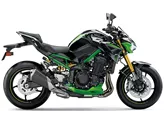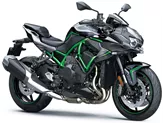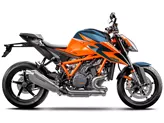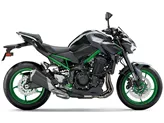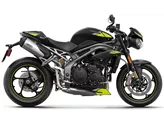Kawasaki Z1000 2014 vs. Kawasaki Z1000 R 2017

Kawasaki Z1000 2014

Kawasaki Z1000 R 2017
Vue d’ensemble - Kawasaki Z1000 2014 vs Kawasaki Z1000 R 2017
The Kawasaki Z1000 model year 2014 and the Kawasaki Z1000 R model year 2017 are both naked bikes with similar technical specifications. They both have an in-line engine with 142 HP of power and 111 Nm of torque. The engine is liquid-cooled and has four cylinders with a displacement of 1043 ccm. Both bikes also have an upside-down telescopic fork front suspension with compression, preload, and rebound adjustment, as well as a double disk front brake with four pistons.
The main difference between the two models lies in the front brake technology. The Kawasaki Z1000 2014 has a radial, petal brake technology, while the Kawasaki Z1000 R 2017 has a radial, monoblock, petal brake technology. This suggests that the Z1000 R 2017 has a higher level of braking performance and stability compared to the Z1000 2014.

Kawasaki Z1000 2014
In terms of dimensions and weights, both bikes have the same front and rear tire widths and diameters, as well as the same wheelbase, seat height, and kerb weight. However, the Z1000 R 2017 has a larger fuel tank capacity of 17 liters compared to the Z1000 2014's 15 liters.
In terms of strengths, the Z1000 2014 is praised for its sophisticated design, extremely pleasant handling, pleasant sound, and good brakes. On the other hand, the Z1000 R 2017 is praised for its powerful and powerful naked bike engine, high-quality and superior chassis, and the ability to provide a real naked bike feeling without the hecticness of a supersport bike.

Kawasaki Z1000 R 2017
In terms of weaknesses, the Z1000 2014 is criticized for its high purchase price compared to the S1000R. On the other hand, the Z1000 R 2017 is criticized for having a little steering angle and lacking a shift assistant.
Overall, both the Kawasaki Z1000 2014 and the Kawasaki Z1000 R 2017 are powerful and capable naked bikes with their own strengths and weaknesses. The Z1000 R 2017 offers a higher level of braking performance and stability, while the Z1000 2014 has a more affordable price.
Caractéristiques techniques Kawasaki Z1000 2014 par rapport à Kawasaki Z1000 R 2017
Avantages et inconvénients en comparaison
Avantages et inconvénients en comparaison
Kawasaki Z1000 2014

La Kawasaki Z1000 (2014) est une déclaration contre la tendance électronique de son époque - et c'est précisément ce qui la rend particulière aujourd'hui. Son quatre cylindres au caractère bien trempé, sa mécanique directe et sa focalisation sans compromis sur l'essentiel répondent aux attentes d'une époque où de nombreuses motos sont devenues des ordinateurs roulants. Oui, elle renonce aux systèmes avancés d'aide au pilote et à une protection parfaite contre le vent. Mais elle offre en contrepartie une authentique expérience de conduite de nakedbike, associée à la fiabilité japonaise et à des coûts d'entretien raisonnables. La Z1000 n'est pas une machine pour les drogués de la fiche technique ou les fans d'électronique - c'est une moto pour ceux qui veulent encore décider eux-mêmes de leur conduite. Une moto honnête avec du caractère, qui continue à enthousiasmer même après des années et qui fait plus que remplir son rôle d'antithèse émotionnelle de la modernité Digital.
Kawasaki Z1000 R 2017

Bien sûr, sur le papier, la Z1000R est inférieure aux Powernakeds actuels et, dans un classement classique, elle perd aussi face à la Z900, tout simplement parfaite. MAIS elle reste fascinante à l'état pur. Tout le monde ne l'aimera pas, mais certains l'adoreront. C'est une moto d'homme vraiment masculine, avec un moteur très souverain et un châssis de l'âge d'or des nakedbikes. La Z1000R est toujours une vraie nakedbike de Supersport Gene - avec ses avantages et ses inconvénients.
Comparaison des prix Prix moyen du marché Kawasaki Z1000 vs Kawasaki Z1000 R
There are a few key differences between a Kawasaki Z1000 2014 and a Kawasaki Z1000 R 2017. In terms of price, the actual average price of a Kawasaki Z1000 R 2017 is about 73% higher. A Kawasaki Z1000 2014 experiences a loss of 660 USD in one year and 490 USD in two years of ownership. This is offset by a loss of 1,020 USD and 3,550 USD for a Kawasaki Z1000 R 2017. Compared to Kawasaki Z1000 R 2017 there are more Kawasaki Z1000 2014 bikes available on the 1000PS.de Marketplace, specifically 12 compared to 4. It takes less time to sell a Kawasaki Z1000 with 75 days compared to 173 days for a Kawasaki Z1000 R. Since model year 2005 1000PS.de editors have written 41 reviews for the Kawasaki Z1000 and 2 reviews for the Kawasaki Z1000 R since model year 2017. The first review for the Kawasaki Z1000 was published on 9/2/2002 and now has more than 5,800 views. This compares to more than 46,400 views for the first review on Kawasaki Z1000 R published on 6/2/2017.




